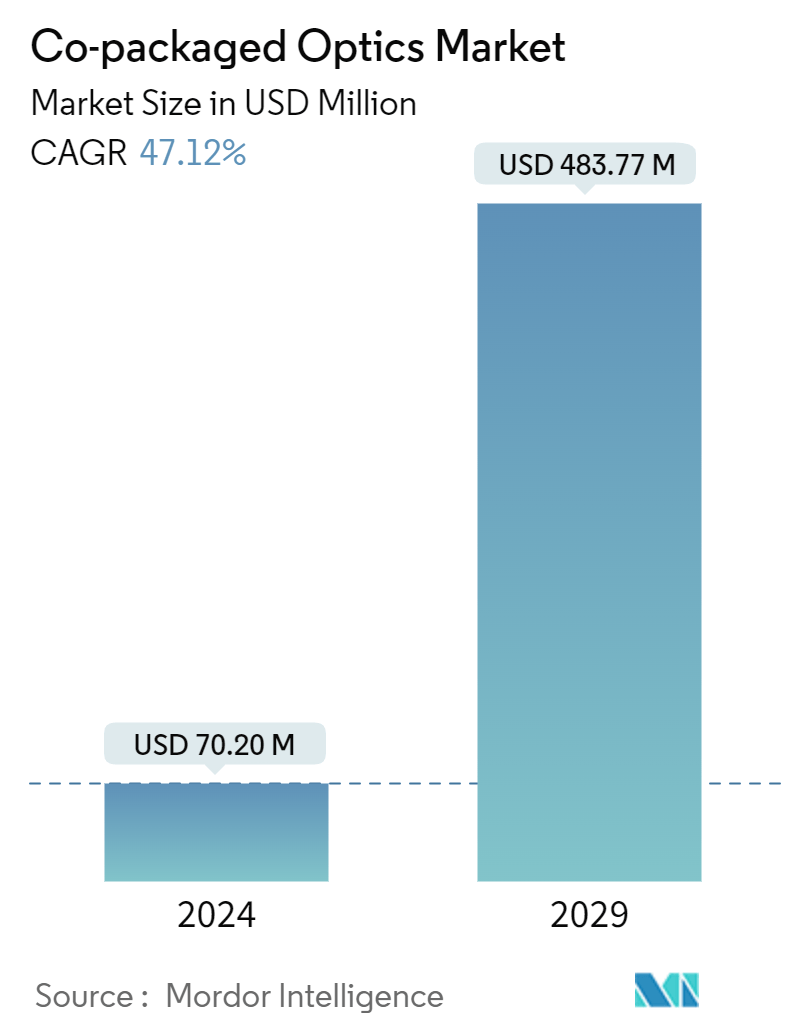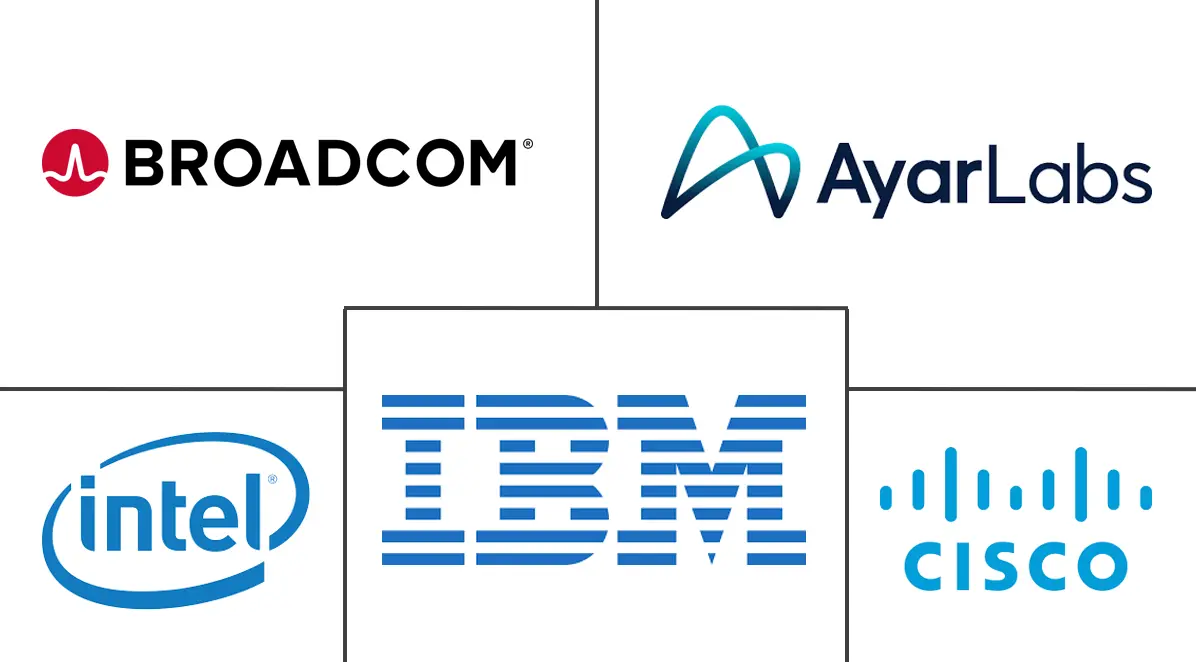Market Size of Co-packaged Optics Industry

| Study Period | 2019 - 2029 |
| Market Size (2024) | USD 70.20 Million |
| Market Size (2029) | USD 483.77 Million |
| CAGR (2024 - 2029) | 47.12 % |
| Fastest Growing Market | Asia Pacific |
| Largest Market | North America |
| Market Concentration | Low |
Major Players
*Disclaimer: Major Players sorted in no particular order |
Co-packaged Optics Market Analysis
The Co-packaged Optics Market size is estimated at USD 70.20 million in 2024, and is expected to reach USD 483.77 million by 2029, growing at a CAGR of 47.12% during the forecast period (2024-2029).
- The co-packaged optics (CPO) market is growing rapidly due to the accelerating demand for high-speed data transmission and the exponential growth of data centers and cloud services. Co-packaged optics integrate optical and electronic components into a single package, reducing the distance that electrical signals need to travel and minimizing latency and power consumption. This addresses the bandwidth limitations of traditional copper interconnects and meets the growing requirements of next-generation data center architectures.
- Moreover, the ongoing shift toward 400 G, 800 G, and beyond in data center networking is a key factor propelling the co-packaged optics market. These higher-speed standards require innovations that CPOs can deliver, such as improved signal integrity and energy efficiency. Data centers require faster, more efficient data processing and transmission capabilities, and CPO technology can support the scaling needs of these data centers.
- The co-packaged optics market is benefiting from collaborations between industry leaders in photonics and semiconductor manufacturing. Companies such as Intel, Cisco, and Broadcom are investing heavily in CPO research and development. These collaborations are essential for advancing the technology, reducing costs, and ensuring interoperability across different platforms.
- The adoption of co-packaged optics is supported by the development of industry standards and regulatory frameworks that ensure the compatibility and reliability of these solutions. Standards associations, including the Institute of Electrical and Electronics Engineers (IEEE) and the Optical Internetworking Forum (OIF), are working to establish guidelines that facilitate the broader deployment of CPO technology.
Co-packaged Optics Industry Segmentation
The co-packaged optics market is segmented by data rates (less than 1.6 T, 1.6 T, 3.2 T, and 6.4 T) and geography (North America, Europe, Asia-Pacific, Latin America, and Middle East and Africa). The market sizes and forecasts are provided in terms of value (USD) for all the above segments.
| By Data Rates | |
| Less than 1.6 T | |
| 1.6 T | |
| 3.2 T | |
| 6.4 T |
| By Geography | |
| North America | |
| Europe | |
| Asia | |
| Australia and New Zealand | |
| Latin America | |
| Middle East and Africa |
Co-packaged Optics Market Size Summary
The co-packaged optics market is experiencing rapid expansion, driven by the increasing demand for high-speed data transmission and the burgeoning growth of data centers and cloud services. This technology integrates optical and electronic components into a single package, significantly reducing latency and power consumption while addressing the bandwidth limitations of traditional copper interconnects. The shift towards higher-speed standards, such as 400 G and 800 G, is a major factor propelling market growth, as these standards necessitate innovations that co-packaged optics can provide. Collaborations among industry leaders in photonics and semiconductor manufacturing, such as Intel, Cisco, and Broadcom, are crucial for advancing this technology, reducing costs, and ensuring interoperability. The development of industry standards by organizations like the IEEE and OIF further supports the adoption of co-packaged optics by ensuring compatibility and reliability.
In the Asia-Pacific region, the co-packaged optics market is witnessing significant growth due to advancements in data centers, telecommunications, and high-performance computing sectors. Countries like China, Japan, and South Korea are leading the charge, investing heavily in next-generation network infrastructure to meet the rising demand for faster data transmission solutions. The region's strong manufacturing base, supportive government policies, and substantial R&D investments are fostering innovation in co-packaged optics technology. The market's growth is further fueled by the implementation of 5G networks, the expansion of cloud services, and the evolution of AI and IoT applications. Globally, the market is highly fragmented, with major players focusing on expanding their customer base and leveraging strategic collaborations to enhance market share and profitability.
Co-packaged Optics Market Size - Table of Contents
-
1. MARKET INSIGHTS
-
1.1 Market Overview
-
1.2 Industry Value Chain Analysis
-
1.3 Industry Attractiveness - Porter's Five Forces Analysis
-
1.3.1 Threat of New Entrants
-
1.3.2 Bargaining Power of Buyers
-
1.3.3 Bargaining Power of Suppliers
-
1.3.4 Threat of Substitute Products
-
1.3.5 Intensity of Competitive Rivalry
-
-
1.4 Assessment of Impact of COVID-19 on the Industry
-
1.5 Impact of Latency-Sensitive Traffic on Demand for CPO
-
1.5.1 AI and Machine Learning in Data Centers
-
1.5.2 5G, CPO, and the Impact on Data Centers
-
1.5.3 Video Conferencing and Online Events
-
-
-
2. MARKET SEGMENTATION
-
2.1 By Data Rates
-
2.1.1 Less than 1.6 T
-
2.1.2 1.6 T
-
2.1.3 3.2 T
-
2.1.4 6.4 T
-
-
2.2 By Geography
-
2.2.1 North America
-
2.2.2 Europe
-
2.2.3 Asia
-
2.2.4 Australia and New Zealand
-
2.2.5 Latin America
-
2.2.6 Middle East and Africa
-
-
Co-packaged Optics Market Size FAQs
How big is the Co-packaged Optics Market?
The Co-packaged Optics Market size is expected to reach USD 70.20 million in 2024 and grow at a CAGR of 47.12% to reach USD 483.77 million by 2029.
What is the current Co-packaged Optics Market size?
In 2024, the Co-packaged Optics Market size is expected to reach USD 70.20 million.

